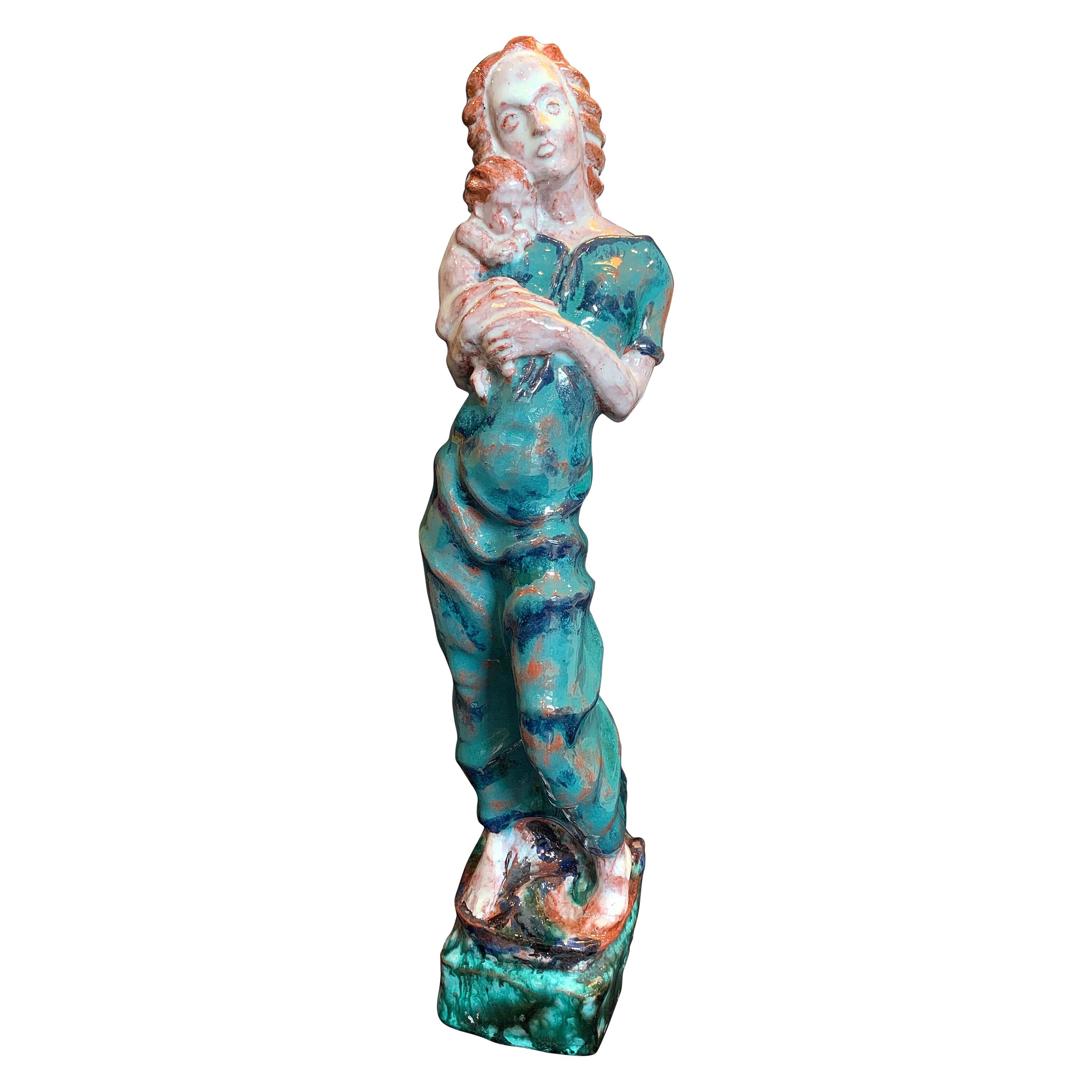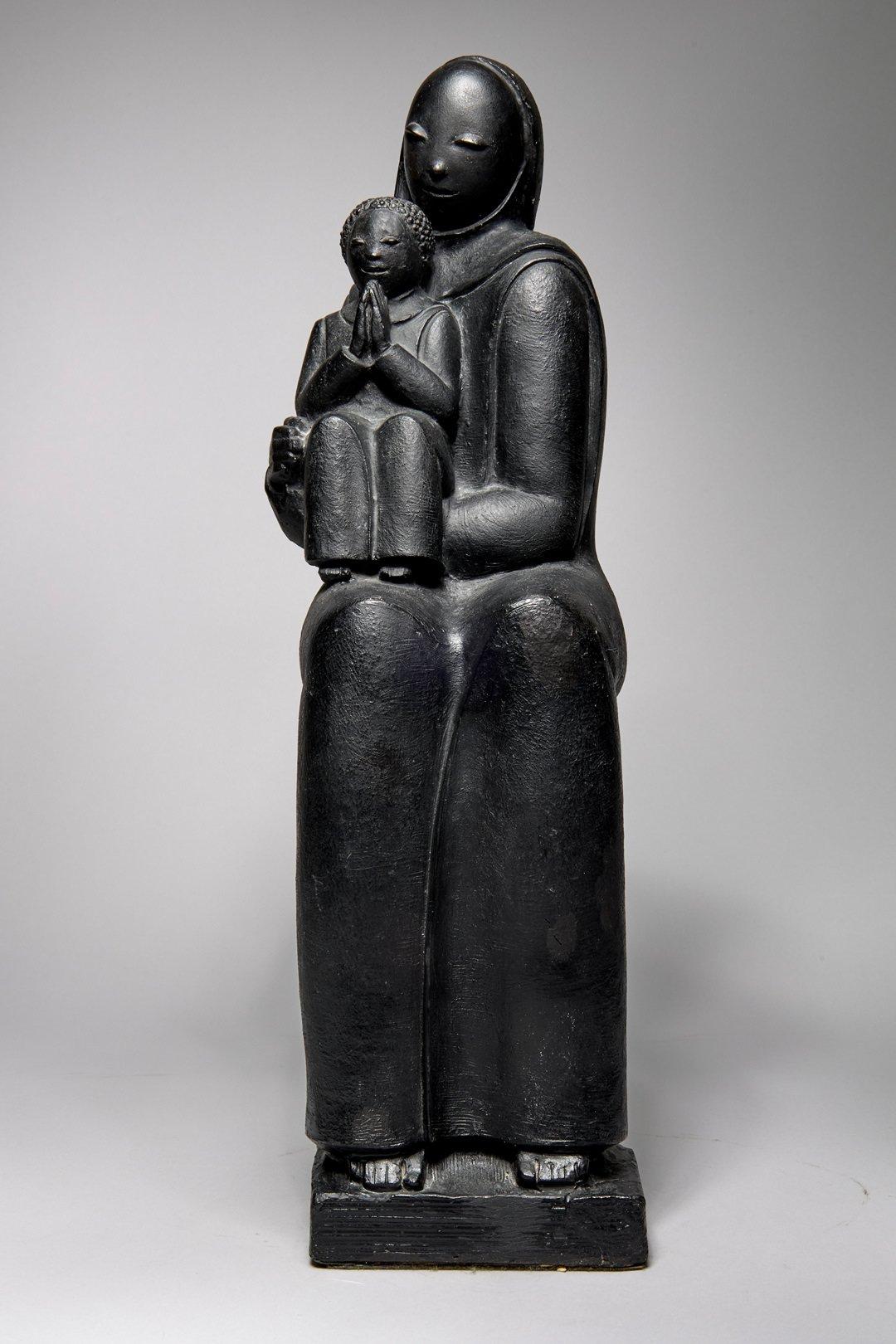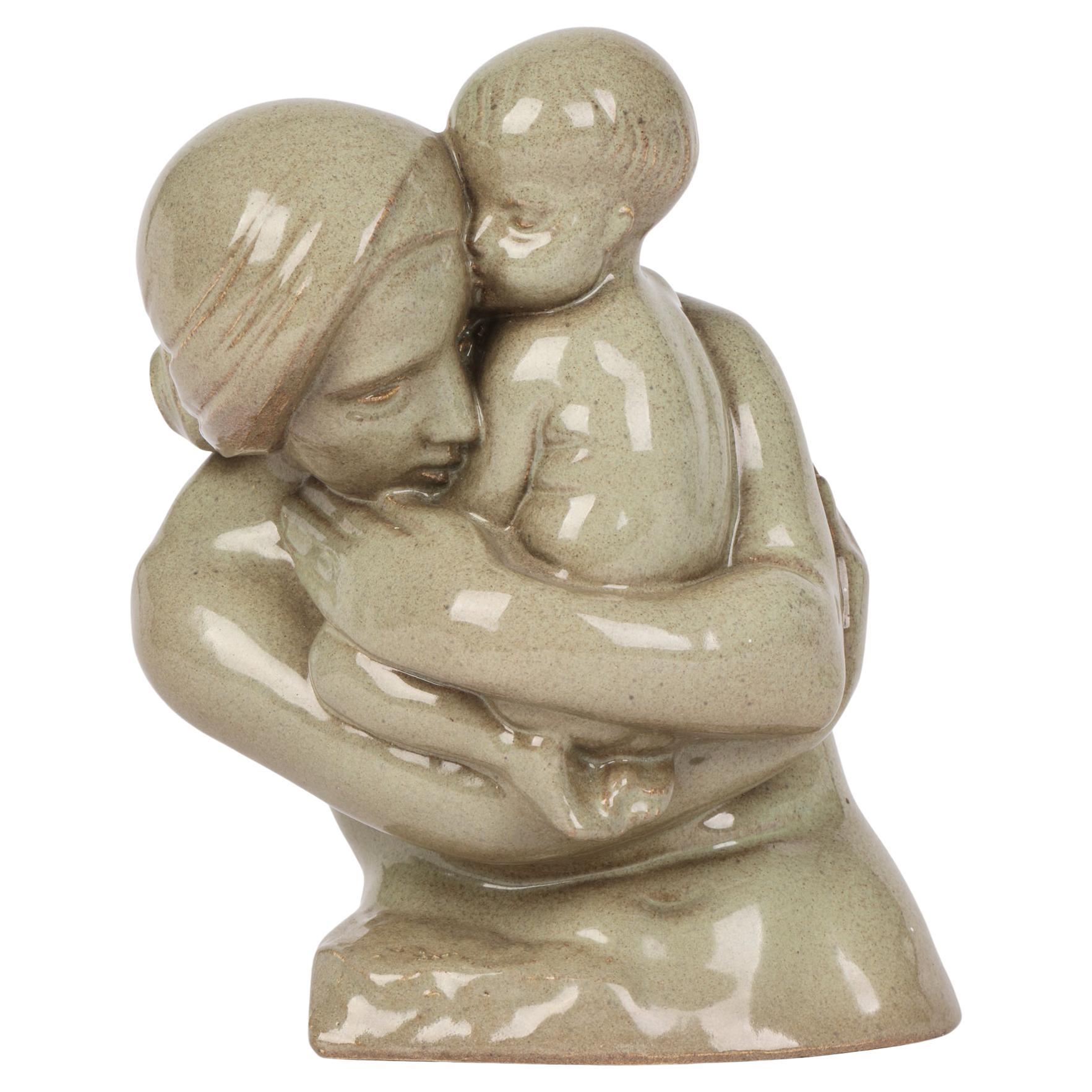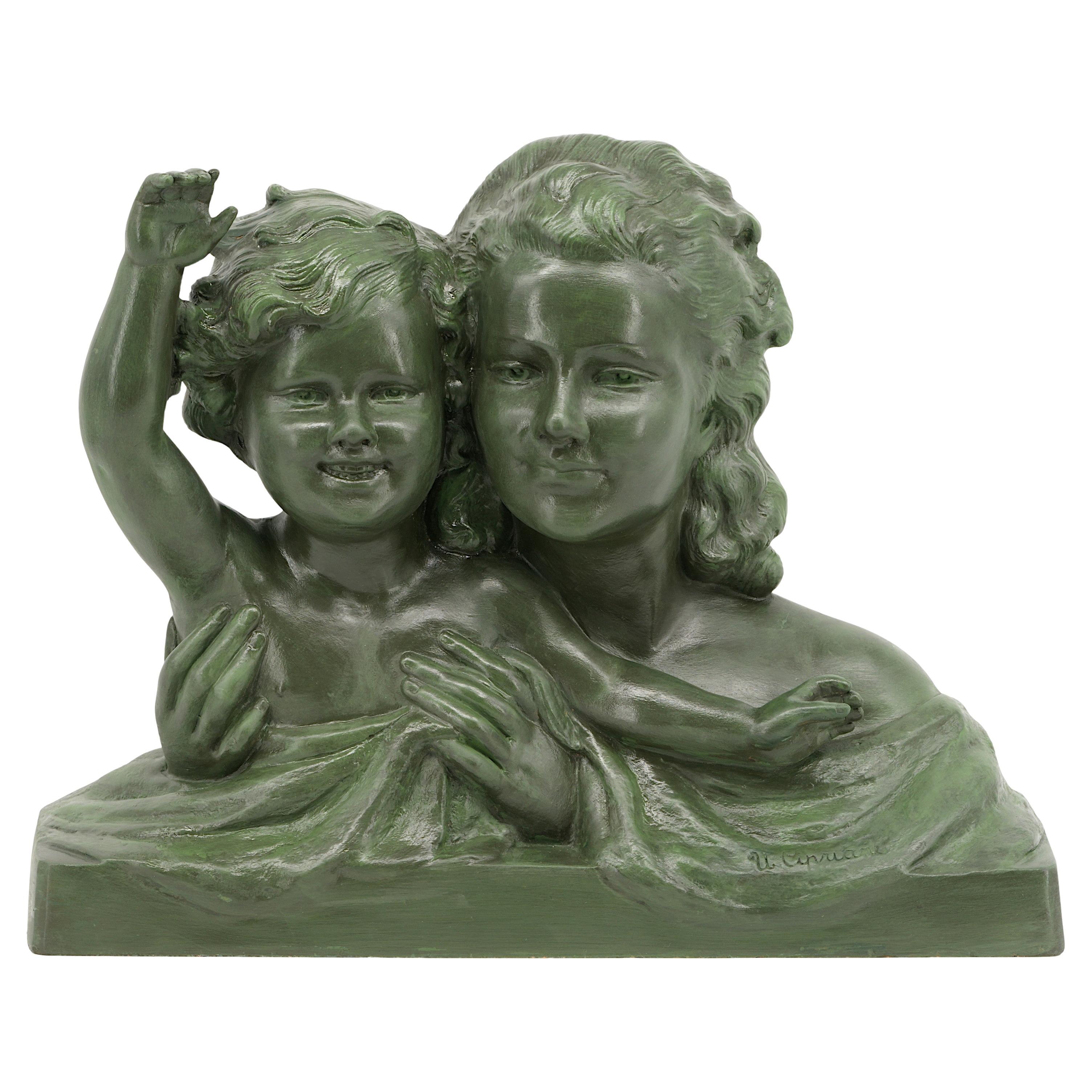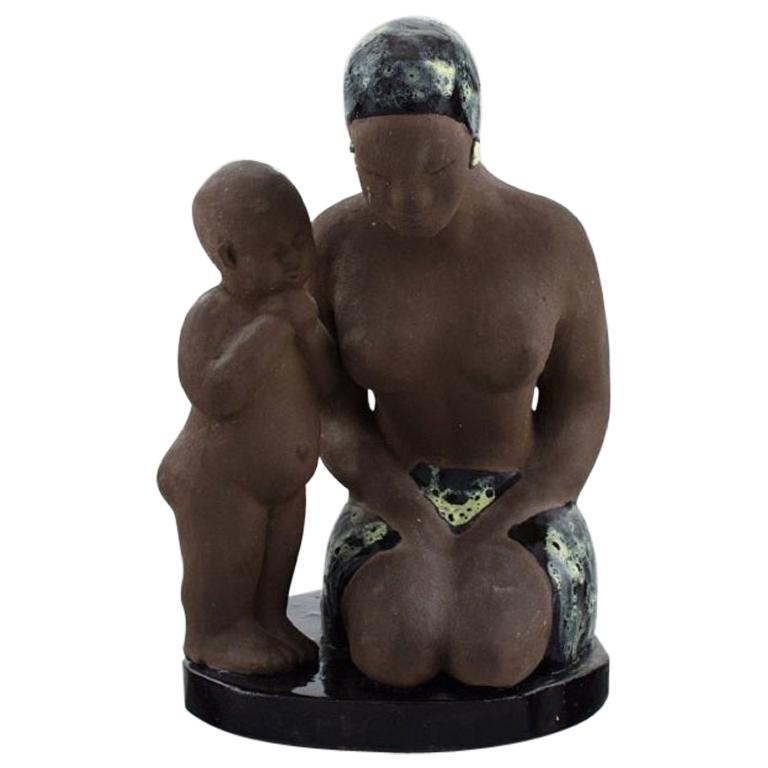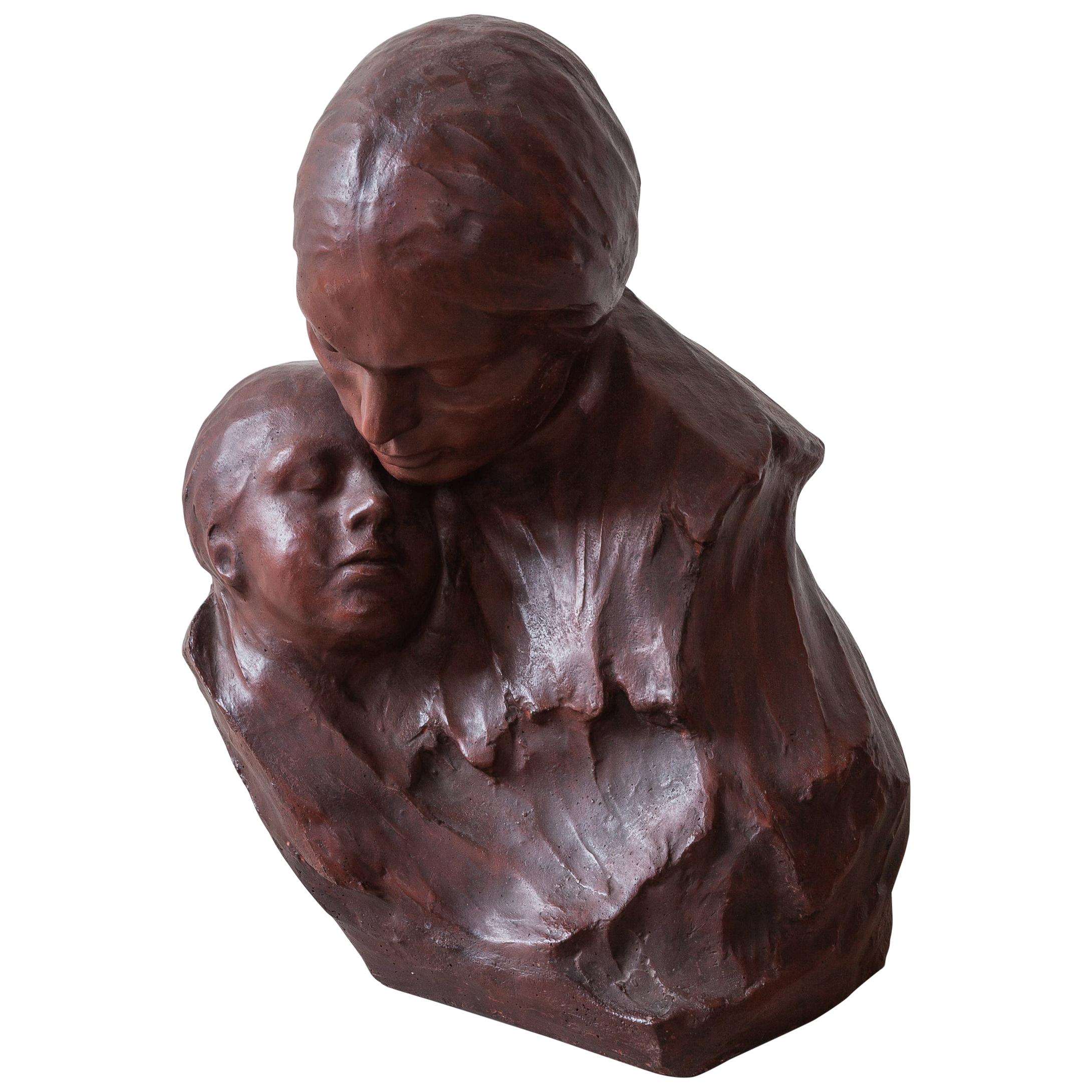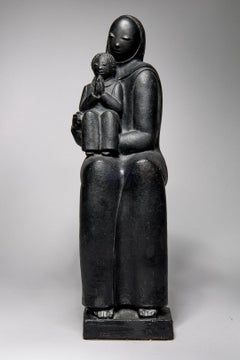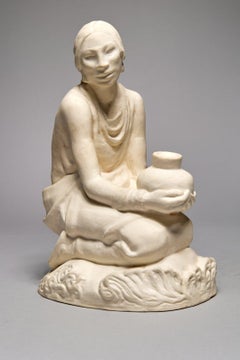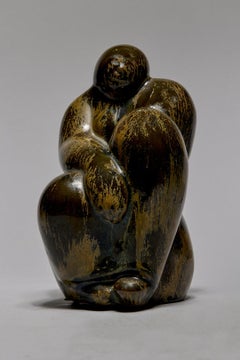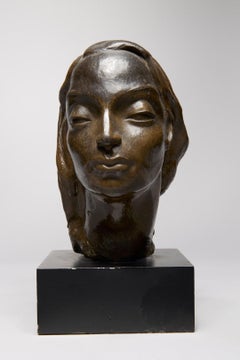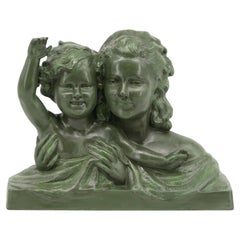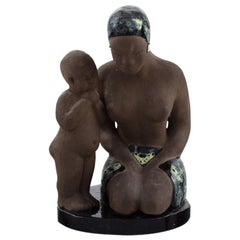Items Similar to Woman and Child, Early 20th Century Ceramic, Female Cleveland School Artist
Video Loading
Want more images or videos?
Request additional images or videos from the seller
1 of 7
Thelma Frazier WinterWoman and Child, Early 20th Century Ceramic, Female Cleveland School Artistc. 1935
c. 1935
$2,200
£1,682.02
€1,937.34
CA$3,082.87
A$3,441.74
CHF 1,803.42
MX$42,130.27
NOK 22,903.45
SEK 21,595.04
DKK 14,458.60
About the Item
Thelma Frazier Winter (American, 1903-1977)
Woman and Child, c. 1935
Glazed stoneware, painted plaster
14 x 7 x 5.875 inches
Thelma Frazier Winter was an American enamelist, ceramic sculptor, and painter. She worked at Cowan Pottery and belonged to the Cleveland School of artists.
Thelma Frazier was born in Gnadenhutten, Ohio, to Robert Frazier and Esther Eggenberg; her family was descended from early Moravian settlers. She grew up in New Philadelphia, Ohio. Encouraged by her mother, she went on to study at the Cleveland School of Art, where she trained in drawing, painting and design with Julius Mihalik and ceramics with R. Guy Cowan. She credited Cowan with introducing her to the medium of ceramics, telling an interviewer in 1952: “Ceramic sculpture, built directly of vitreous clay, fired and glazed, was a revolutionary idea to me. Clay, such a responsive medium, summons all one’s ingenuity and adventurous impulse. Add the dimension of color and its possibilities are really exciting. I felt at once that this was my medium.”
She completed her degree in 1929 and then worked for two years at Cowan Pottery before leaving in the early 1930s to pursue a bachelor's degree in art education at Western Reserve University. Graduating in 1935, she went on to teach at the Laurel School in Cleveland (1939–45) and the Cleveland Institute of Art (1945–50).
Winter became known for her polychrome ceramic work, and especially for her use of glaze and color. Her work consistently featured highly stylized human and animal figures. Her style ranged from an expressive Modernism influenced by the Wiener Werkstätte and Cubism to a cartoon-like style for some of the animal figurines. In 1939, she won the prestigious first prize for sculpture at Syracuse Museum of Fine Art’s National Ceramics Exhibition.
In 1973, she published a book, Art and Craft of Ceramic Sculpture, that introduced a new generation of American artists to the potential of her medium.
In the 1950s, Winter began working with enamels. Her husband was a well-known enamelist, and the pair worked both independently and collaboratively on projects large and small, including sizable enamel murals—including eleven commissioned by churches—and household decorative items ranging from sculptures to ashtrays. Thelma said of her enamel work: "One of the most exciting experiences of my life began when I started to work with enamels.... I could transfer all I had learned in the other mediums to my enamels so that they have a style which is completely personal."
Winter's work is part of the comprehensive ceramics collection at the Everson Museum (formerly the Syracuse Fine Arts Museum) in Syracuse, New York, originally assembled in 1916. It started with the purchase of thirty-two porcelains created by another woman artist, renowned potter Adelaïde Alsop Robineau (1865-1929) in the early 1900s. Fernando Carter, then the director, quickly expanded its scope, acquiring historic and iconic pottery works internationally. However, Carter also presented art by respected and innovative national ceramicists, including examples by Winter such as her Juggler (circa 1949).
In December 1939, she married H. Edward Winter, who was also an artist. They were longtime residents of the University Circle neighborhood of Cleveland.
Thelma Frazier Winter died of cancer in 1977, one year after her husband's death, and is buried in Lake View Cemetery in Cleveland, Ohio.
About the Seller
5.0
Vetted Professional Seller
Every seller passes strict standards for authenticity and reliability
Established in 1975
1stDibs seller since 2022
34 sales on 1stDibs
Typical response time: <1 hour
- ShippingRetrieving quote...Shipping from: Beachwood, OH
- Return Policy
Authenticity Guarantee
In the unlikely event there’s an issue with an item’s authenticity, contact us within 1 year for a full refund. DetailsMoney-Back Guarantee
If your item is not as described, is damaged in transit, or does not arrive, contact us within 7 days for a full refund. Details24-Hour Cancellation
You have a 24-hour grace period in which to reconsider your purchase, with no questions asked.Vetted Professional Sellers
Our world-class sellers must adhere to strict standards for service and quality, maintaining the integrity of our listings.Price-Match Guarantee
If you find that a seller listed the same item for a lower price elsewhere, we’ll match it.Trusted Global Delivery
Our best-in-class carrier network provides specialized shipping options worldwide, including custom delivery.More From This Seller
View AllMother and Child, Mid-20th Century sculpture, Cleveland School Artist
Located in Beachwood, OH
Walter Sinz (American, 1881-1966)
Mother and Child, 1949
Plaster
Signed and dated on base
23.5 x 6 x 9 inches
Walter A. Sinz was an American sculptor born in Cleveland, Ohio on Jul...
Category
1940s Figurative Sculptures
Materials
Plaster
Early 20th Century Cowan Pottery Ceramic Sculpture of a Native American
By F. Luis Mora
Located in Beachwood, OH
F. Luis Mora (American, 1874-1940)
Native American, c. 1930s
Ceramic
Stamped on bottom, Cowan Pottery
9 x 7 x 5 inches
Francis Luis Mora was one of the better-known American artists...
Category
1930s Figurative Sculptures
Materials
Ceramic
Mid-Century Ceramic Sculpture of a Seated Female, Cleveland School Artist
Located in Beachwood, OH
Walter Sinz (American, 1881-1966)
Seated Female, c. 1940
Ceramic
6 x 3.5 x 3.5 inches
Walter A. Sinz was an American sculptor born in Cleveland, Ohio on July 13, 1881. Sinz’s fathe...
Category
1940s Figurative Sculptures
Materials
Ceramic
Early 20th Century Ceramic Bust of a Woman, Cleveland School Artist
Located in Beachwood, OH
Edris Eckhardt (American, 1905-1998)
Bust, 1933
Ceramic
Signed and dated base
8.5 x 4.5 x 4.5 inches, including base
Born in Cleveland, Ohio January 28, 1905, Edris was given the na...
Category
1930s Figurative Sculptures
Materials
Ceramic
Zinnia, early 20th century sculpture of nude bust of woman, Cleveland School
Located in Beachwood, OH
Walter Sinz (American, 1881-1966)
Zinnia, c. 1930
Plaster
Signed on base
9 x 8 x 4 inches
Walter A. Sinz was an American sculptor born in Cleveland, Ohio on July 13, 1881. Sinz’s fa...
Category
1930s Figurative Sculptures
Materials
Plaster
Nude Walking, Early 20th Century Bronze Sculpture, Cleveland School Artist
By Max Kalish
Located in Beachwood, OH
Max Kalish (American, 1891-1945)
Nude Walking, 1930
Bronze
Signed and dated on base
17 x 9 x 4 inches
Born in Poland March 1, 1891, figurative sculptor Max Kalish came to the United States in 1894, his family settling in Ohio. A talented youth, Kalish enrolled at the Cleveland Institute of Art as a fifteen-year-old, receiving a first-place award for modeling the figure during studies with Herman Matzen. Kalish went to New York City following graduation, studying with Isidore Konti and Herbert Adams...
Category
1930s American Modern Figurative Sculptures
Materials
Bronze
You May Also Like
"Mother and Child, " Brilliantly-Glazed Ceramic Sculpture by Wiener Werkstätte
Located in Philadelphia, PA
Glazed in the gorgeous, brilliant glazes characteristic of the Wiener Werkstätte (Vienna Workshop), and adopting a long, lean, almost Mannerist pose, this lovely sculpture of a mothe...
Category
Vintage 1920s Austrian Art Deco Figurative Sculptures
Materials
Chenille
Christine Gregory Art Deco Pottery Mother & Child Glazed Sculpture Dated 1933
Located in Bishop's Stortford, Hertfordshire
A beautiful Art Deco pottery sculpture of a mother and child by Christine Gregory (British, 1879-1965) dated 1933. This very tender and well observed portrayal shows the mother holding the child wrapped in her arms and held cheek to cheek...
Category
Vintage 1930s English Art Deco Figurative Sculptures
Materials
Pottery
Ugo Cipriani French Large Art Deco Terracotta Mother and Child Sculpture, 1920
By Ugo Cipriani
Located in Saint-Amans-des-Cots, FR
French Art Deco terracotta sculpture by Ugo Cipriani (1887-1960), France, 1920. Mother and child. Terracotta patinated bronze. Measures: Width 17.7" (45cm), height 14" (35.5cm), dept...
Category
Vintage 1920s French Art Deco Figurative Sculptures
Materials
Terracotta
Bengt Wall, Sweden, Balinese Girl with Child in Raw and Glazed Ceramics, 1950s
Located in København, Copenhagen
Bengt wall, Sweden. Balinese girl with child in raw and glazed ceramics, 1950s.
Measures: 19.5 x 14 cm.
In very good condition.
Signed.
Category
Vintage 1950s Swedish Figurative Sculptures
Materials
Ceramic
Ceramic Art Deco Buste Mother and Child by Belgium Artist G.Wasterlain
Located in Antwerp, BE
Art Deco large sculpture in ceramic of a Mother and Child by Belgian sculpture, Georges Wasterlain. Glazed reddish-brown stoneware with no chips or d...
Category
Vintage 1930s Belgian Art Deco Busts
Materials
Ceramic
$2,551 Sale Price
20% Off
Frank Vittor Italian/American Sculptor Mother and Child Bronze, 1915
By Frank Vittor
Located in Phoenix, AZ
Frank Vittor (1888-1966) important bronze of mother and child.
Signed by the artist “F. Vittor” and dated 1915. Also bears the foundry mark.
Measures 12 1/2"h x 12 ½”w x 9"long. Bronze rests on a 1 ½ inch marble plinth.
Artist born in Italy, studied with Rodin. The foundry is the National Art bronze works.
The bronze was converted to a lamp at one point, and still bears a threaded tube projecting
from the lower base approximately ½ inch.
Frank Vittor (January, 6, 1888 - January 24, 1968) was an Italian immigrant to the United States who became famous as a sculptor.
Vittor was born in Mozzato, Como, a suburb of Milan, Italy. He studied art in Milan at the Academy of Beres and then traveled to Paris, France to study under Auguste Rodin. When Vittor was 18, in 1906, U.S. architect Stanford White brought Vittor to New York to work on his staff. White, who had designed Madison Square Garden II, was murdered at a performance at The Garden two weeks after Vittor arrived. The youth, having little money and knowing very limited English, decided to stay in America and soon opened an art studio. He met his future wife, Ade Mae Humphreys, a resident of Pittsburgh, and made the move to her home town.
Aviator Charles Lindbergh's first solo trans-Atlantic 3,600-mile (5,800 km) flight between Long Island, New York and Paris, France was immortalized in bronze by Vittor with a 50-foot-tall (15 m) sculpture showing a winged youth spanning the Statue of Liberty and the Eiffel Tower. Congress approved the expenditure in 1928, and the work was completed in 1929.
Perhaps no work by Vittor created as much controversy and media coverage as did his nude statue of Henrietta Leaver, Miss America 1935. Though Leaver posed for Vittor, she did so in a bathing suit, accompanied by her grandmother. Upon first viewing the life-size 5-foot 5-inch plaster statue Leaver was shocked that it was a nude and demanded her representation be draped or veiled. Vittor did not agree and called in art experts to judge the work and all agreed it should stay as it had been created. Leaver did not back down and demanded people her own age review The American Venus, as it had originally been called. Unfortunately for Leaver her 60 peers, many of whom were art students, agreed it should remain unveiled. Though the strong disagreement between the two eventually did subside, Leaver, Vittor and the statue resurfaced five decades later in recaps of controversial Miss America mishaps.
Baseball player Honus Wagner, one of the first five players inducted into the Hall of Fame, was memorialized by Vittor in a 17-foot-tall (5.2 m) bronze statue, originally on display near the Pittsburgh Pirates Forbes Field. It was moved to Three Rivers Stadium and, when that stadium was imploded in 1971, the statue was relocated to PNC Park.[6]
In 1958, one of Vittor's greatest works, a 50-foot-tall (15 m) granite base and bronze statue of Christopher Columbus, was unveiled in Pittsburgh's Schenley Park. Shortly after the statue was placed, the bronze plaque at the base was stolen by vandals. The Sons of Columbus USA desire to replace the plaque with the original wording; however, there exists no record of what Vittor had written regarding Columbus.
Charles Lindbergh was the recipient of a second work of art created by Vittor. The artist and sculptor designed a commemorative stamp picturing the pilot and his plane, the Spirit of St. Louis.
Walter F. Brown, the U.S. Postmaster General, authorized a 175th anniversary commemorative "Battle of Braddock" 2-cent stamp to be designed by Vittor. The artwork he created featured a likeness of Colonel George Washington with the inscription "Battle of Braddock's Field, 1755-1930.
In 1936 the U.S. Congress authorized minting a half-dollar coin to commemorate the 75th anniversary of the American Civil War. Vittor was the person selected to design the coin. The obverse depicts the profile of two soldiers, one from the North and one from the South and the reverse holds a symbol of the battle placed between the combatant's shields. The coins were distributed through the Pennsylvania State Commission for Gettysburg.
Throughout Pittsburgh and the surrounding communities there exist more than 50 statues and fountains, as well as numerous other works, including a dozen historical panels on County bridges...
Category
Early 20th Century Figurative Sculptures
Materials
Bronze
More Ways To Browse
Ceramic Sculpture Woman
Female Pottery
Plaster Woman Sculpture
Woman Ceramic Figurine
1930 Wiener Werkstatte
Vintage Clay Figurines
Ohio Stoneware
Adelaide Robineau
Moravian Pottery
Thelma Frazier Winter
Riho Kuld
Rodin Man With Broken Nose
Rosendo Porro Cuesta
Ruslan Karablin
Sacred Langur
Salvador Dali Bas Relief Silver
Sergei Isupov
Sydney Kumalo
